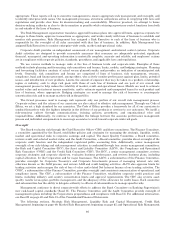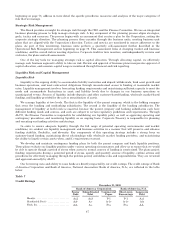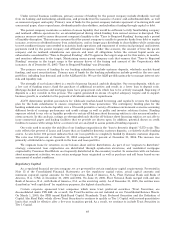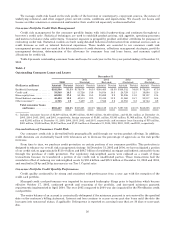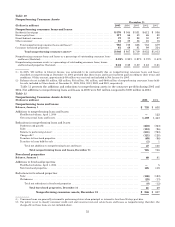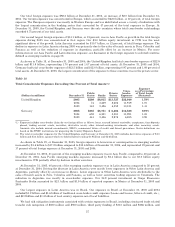Bank of America 2005 Annual Report Download - page 85
Download and view the complete annual report
Please find page 85 of the 2005 Bank of America annual report below. You can navigate through the pages in the report by either clicking on the pages listed below, or by using the keyword search tool below to find specific information within the annual report.The FRB’s Final Rule limits restricted core capital elements to 15 percent for internationally active bank holding
companies. In addition, the FRB revised the qualitative standards for capital instruments included in regulatory capital.
Internationally active bank holding companies are those with consolidated assets greater than $250 billion or on-balance
sheet exposure greater than $10 billion. At December 31, 2005, our restricted core capital elements comprised 16.6
percent of total core capital elements. We expect to be fully compliant with the revised limits prior to the implementation
date of March 31, 2009.
Basel II
In June 2004, Basel II was published with the intent of more closely aligning regulatory capital requirements with
underlying risks. Similar to economic capital measures, Basel II seeks to address credit risk, market risk and
operational risk.
While economic capital is measured to cover unexpected losses, we also maintain a certain threshold in terms of
regulatory capital to adhere to legal standards of capital adequacy. With recent updates to the U.S. implementation,
these thresholds or leverage ratios, will continue to be utilized for the foreseeable future. Maintaining capital adequacy
with our regulatory capital under Basel II, does not impact internal profitability or pricing.
In the U.S., Basel II will not be implemented until January 1, 2008, which will serve as our parallel test year,
followed by full implementation in 2009. The impact on our capital management processes and capital requirements
continues to be evaluated. As Basel II is an international regulation, U.S. regulatory agencies are drafting a U.S.
oriented measure which follows the Basel II construct.
Recently, an assessment of the potential effect on regulatory capital known as Quantitative Impact Study 4 was
completed, which generated disparate results among participants. In order to address the potential changes in capital
levels, regulators have established floors or limits as to how much capital can decrease from period to period after full
implementation through at least 2011. We are committed to working with the regulators and continue to proactively
monitor their efforts towards achieving a successful implementation of Basel II.
Implementation of Basel II requires a significant enterprise-wide effort. During 2005, our dedicated Basel II
Program Management Office, supported by a number of business segment specialists and technologists, completed major
planning activities required to achieve Basel II preparedness. During 2006, we are aggressively moving forward with
policy, process and technology changes required to achieve full compliance by the start of parallel processing in 2008. We
continue to work closely with the regulatory agencies in this process.
Dividends
Effective for the third quarter 2005 dividend, the Board increased the quarterly cash dividend 11 percent from $0.45
to $0.50 per common share. In October 2005, the Board declared a fourth quarter cash dividend which was paid on
December 23, 2005 to common shareholders of record on December 2, 2005. In January 2006, the Board declared a
quarterly cash dividend of $0.50 per common share payable on March 24, 2006 to shareholders of record on March 3,
2006.
Share Repurchases
We will continue to repurchase shares, from time to time, in the open market or in private transactions through our
approved repurchase programs. We repurchased 126.4 million shares of common stock in 2005, which more than offset
the 79.6 million shares issued under our company’s employee stock plans. During 2006 we expect to use available excess
capital to repurchase shares in excess of shares issued under our employee stock plans. For additional information on
common share repurchases, see Note 14 of the Consolidated Financial Statements.
Credit Risk Management
Credit risk is the risk of loss arising from a borrower’s or counterparty’s inability to meet its obligations. Credit risk
can also arise from operational failures that result in an advance, commitment or investment of funds. We define the
credit exposure to a borrower or counterparty as the loss potential arising from all product classifications, including
loans and leases, derivatives, trading account assets, assets held-for-sale, and unfunded lending commitments that
include loan commitments, letters of credit and financial guarantees. For derivative positions, our credit risk is
measured as the net replacement cost in the event the counterparties with contracts in a gain position to us completely
fail to perform under the terms of those contracts. We use the current mark-to-market value to represent credit exposure
without giving consideration to future mark-to-market changes. The credit risk amounts take into consideration the
effects of legally enforceable master netting agreements. Our consumer and commercial credit extension and review
procedures take into account credit exposures that are funded or unfunded. For additional information on derivatives
and credit extension commitments, see Notes 5 and 13 of the Consolidated Financial Statements.
49









